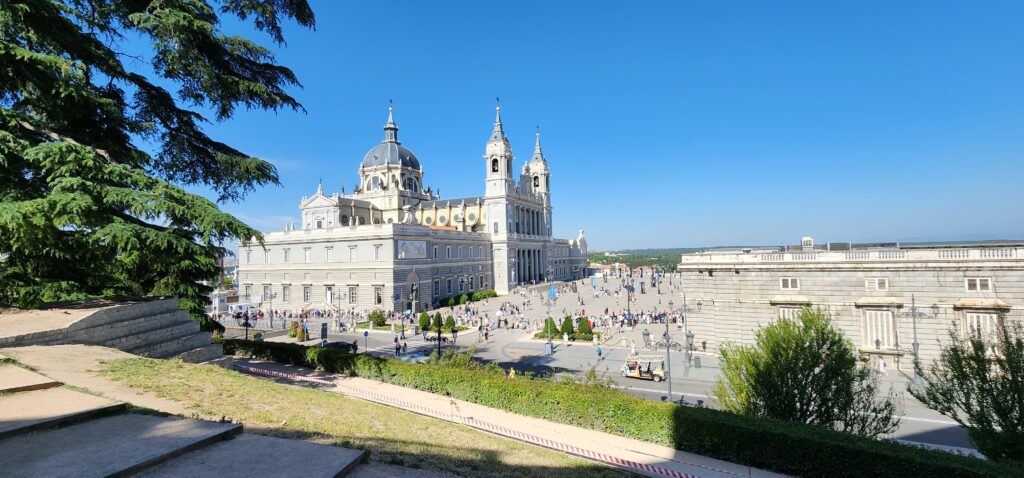
From Sevilla, we took a Renfe Ave train to Madrid and once more it was a comfortable and pleasant train ride. The train coaches have luggage space at both ends and wifi, so the 2-hour 40 minute journey was nice. Glancing at the scenery outside was pleasant. We arrived at the Madrid Atocha train station where you will find plenty of taxis waiting outside to take you to your hotel or destination.
We had 3 nights in the sophisticated capital of Spain, Madrid. In 1469, when the Catholic royals, Ferdinand and Isabel married uniting the kingdoms of Aragon and Castile, Madrid came into the focus, and eventually became the seat of a powerful empire. Today Madrid is vibrant and pulsing with energy. It is a big city, global in nature, not as walkable everywhere as other places we visited in Spain, due to its size, but with all the conveniences of a big city.
Eateries of all cuisines abound everywhere, although I find it rather irritating to find the ubiquitous McDonalds, Burger King, Popeyes and other American fast food all over the place. We made it a point to dine at local Spanish restaurants and enjoyed the local food. For that matter European local cappuccino tasted so much better than Starbucks. Wondering if American fast-food export to the world is a good idea for world health or culture? Each country should protect its local food and culture. And another irritation is the ugly graffiti vandalizing beautiful historic cities unfortunately all over Europe (and no graffiti is not art). It is a shame that graffiti is ruining beautiful cities.
Be wary of pickpockets and random friendly people wanting to give you a rose or talk to you, don’t leave your bag on the floor, on a chair or anywhere, be alert and wear anti-theft sling bags on you. To get around, we simply used taxis which can be found easily everywhere, except on Sunday’s you may need to wait a bit as fewer drivers work. Green light on the taxi roof means it is free.
In Madrid, attractions include: –
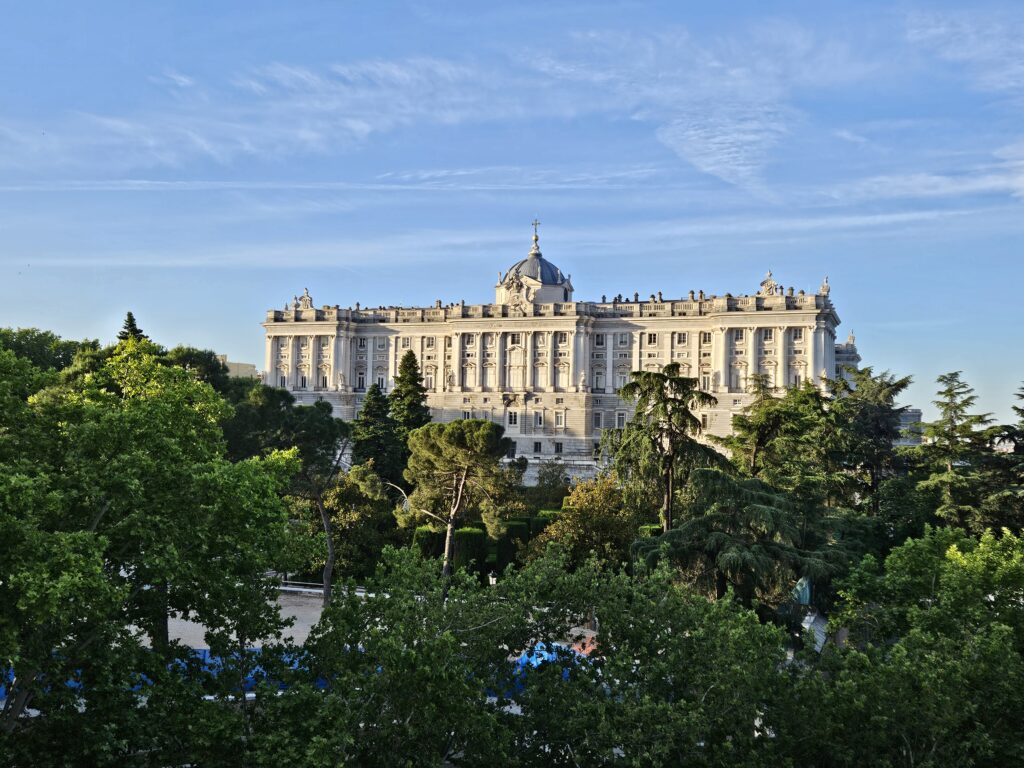
Madrid’s Royal Palace is Europe’s third greatest palace, after Versailles near Paris, and Schönbrunn in Vienna. The palace is majestic and opulent. I had booked tickets for the palace months earlier for Monday, but a few days before, while we were in Sevilla, I received an email that our tickets were being cancelled and we would get a refund back due to official government use of the palace. We realized later that it was because Spain was hosting Ukraine’s President Zelensky. We were extremely disappointed as all the tickets for Tuesday, the one day we had, were sold out on the official palace website. Where the Royal Palace is concerned you have no way of knowing ahead when the palace will be closed for something official but at the same time if you don’t book ahead, chances of getting in are slim.
We had given up hope of visiting the royal palace, when my husband, in doing some google searches found a guided tour company “Fun and Tickets” offering Madrid old town + royal palace guided tour. We purchased the tour skeptical if it included the inside of the palace but to our delight, it was a good tour and included a visit inside the palace. The price was naturally much more than the official tickets but still very much worth it.
Spain’s sumptuous, lavishly furnished national palace is the largest palace in Europe in size with 2800 rooms. The admission to the palace is opposite the cathedral. You first enter the vast open-air courtyard where you can take family photos. You’ll also exit here so you can get pictures afterwards as well. Across the square is the back of the beautiful Almudena Cathedral. Since we were with the tour group, we walked through the gilded, majestic rooms quite fast. But so glad that we had the opportunity to see this beautiful palace.
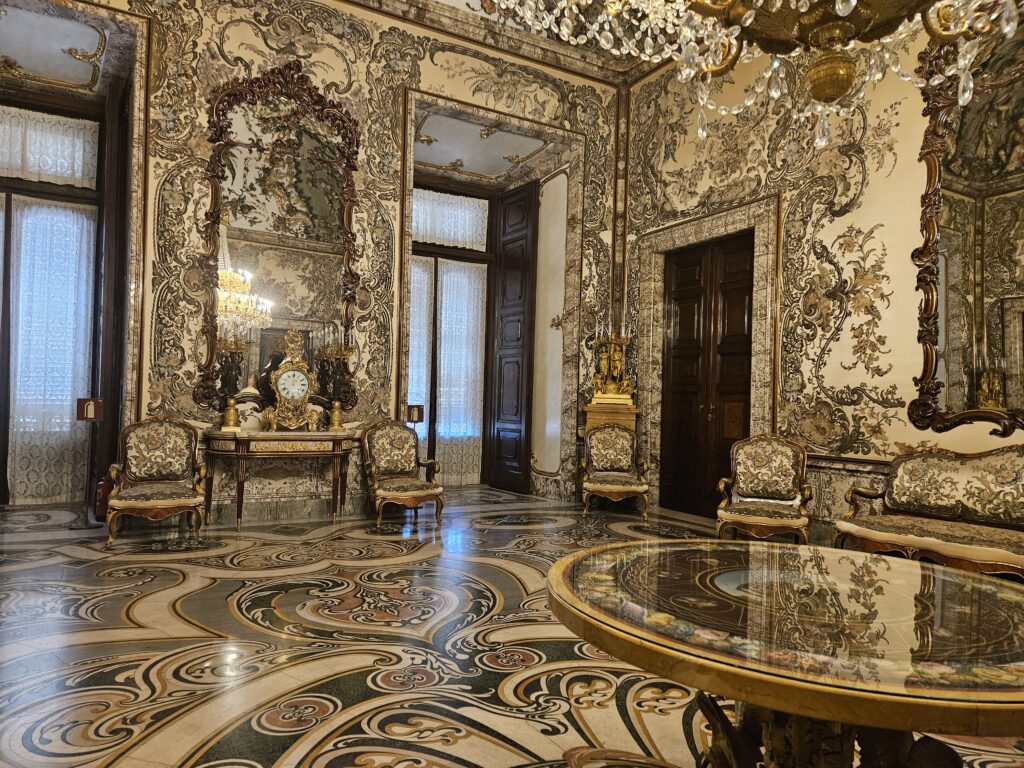
Once you enter the palace, you cannot backtrack on the tour. An imperial staircase, made from a single piece of marble, leads to the Hall of the Halbardiers where you’ll see the first of two wonderful ceiling frescos by the Venetian artist Gianbattista Tiepolo, the great Rococo painter of the 18th century. On the ceiling of the mirrored Throne Room is The Apotheosis of the Spanish Monarchy, an extraordinary fresco. Spain’s glory days are represented in this palace as it’s just one room after the other of over-the-top luxury and opulence, the most magnificent of which is the vast, chandeliered State Dining Hall, first used by Alfonso XII in November 1879 to celebrate his marriage. After the palace, you can also wander Jardines de Sabatini, opened to the public by King Juan Carlos I in 1978.
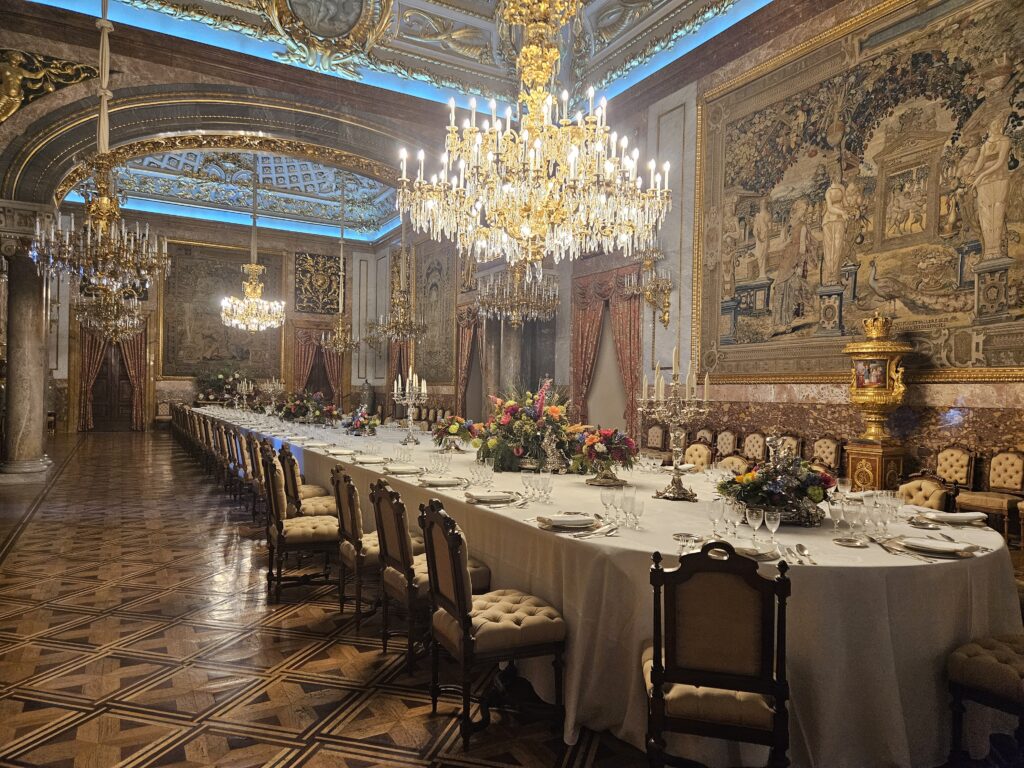
Note that when you enter the royal palace, you have two different lines and only one entry door: The left-hand line is for people with tickets bought online. You’ll queue up to enter through security and will be ushered into an area where you can collect your mobile guides and use the restroom if you need to before entering (heard toilets are not in good condition, bring toilet paper) We were taken in fast through the group line by our operator.
If you go on your own, download the audio guide before the visit and get acquainted with the palace instead of renting the tablets, so you are not staring at the tab instead of enjoying the palace. It can take about 2 hours to tour the entire palace. Photographs are now allowed.
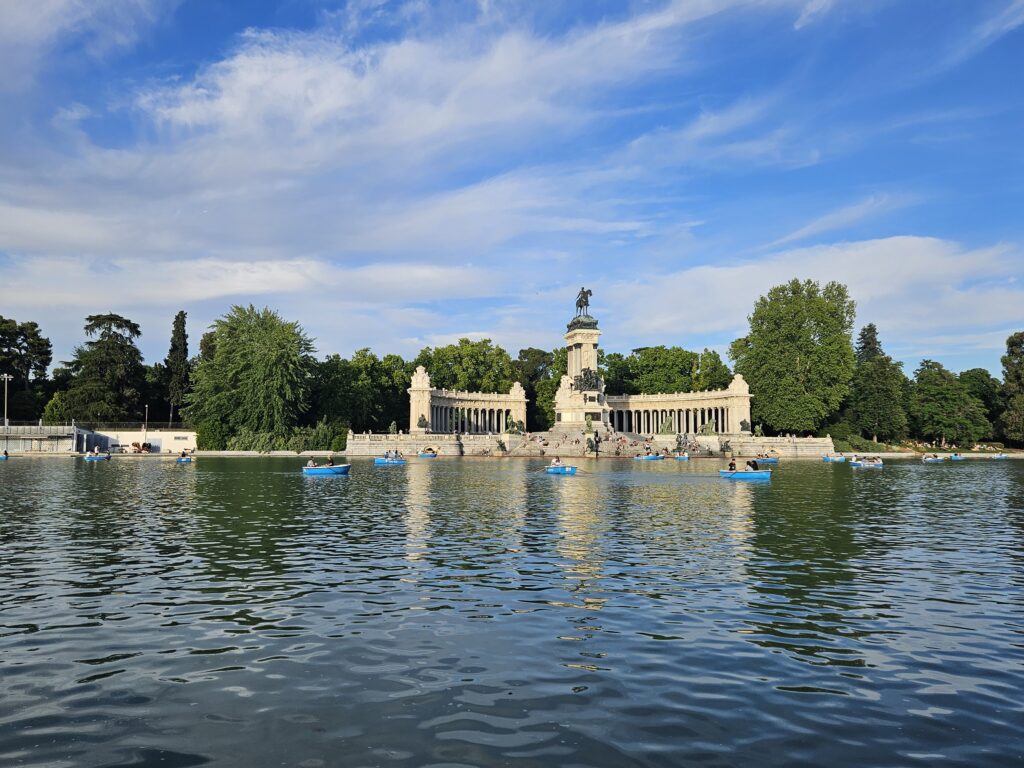
Retiro Park: A lovely festive green escape, public park with free access where people go to escape the din of city life. Enter via the Felipe IV entrance (Alphonse XII street, the gate is in front of the Buen Retiro Palace). The baroque style door gives access to the park via the parterre de Philippe IV which is a beautiful French garden in the park. Unfortunately, the Crystal Palace was closed when we visited, it is said to be the most beautiful or romantic monument in the park. It was built by the Spanish architect Ricardo Velazquez Bosco, who was inspired by the Crystal Palace in London to design it. It is one of the best examples of the so-called iron architecture and was built for the Philippine Exposition (the last Spanish colony) organized in the late nineteenth century by the Spanish government. Retiro park also has the Galapagos Fountain built in the early 19th century by King Fernando VII to commemorate the first anniversary of the birth of his daughter Isabel II. The park has rental rowboats. You can also enjoy a visit to the Rose Garden, the Kings of Spain statue walk and walk through Cypress and olive trees in the forest of remembrance. Another site is the Palacio de Velázquez, an exhibition hall, named after its architect: Ricardo Velázquez Bosco, who also designed the Crystal Palace, built in the 19th century for an exhibition, it shows Arab influence on Spanish architecture.
Puerta del Sol Madrid’s lively central square, like times square in NY, there are many pickpockets and other unsavory characters, be careful of the stores that try to sell you postage stamps for postcards, they are fake. Look for the Statue of King Carlos III, the bear and the famous clock. Just outside the Casa de Correos, tourists can see a stone slab on the pavement, marking Kilometer Zero: the official starting point for Spain‘s six national roads.
Women’s Walking shoes
Anti-theft bags
Gran Via – Madrid’s main historical street with landmarks like Circulo de Bellas Artes, Metropolis bldg and Telefonica. Avoid Calle de la Montera, a street known for prostitution and unsafe
Plaza Mayor Historic cobbled square.
Puerta de Alcala – Located on a large roundabout in Plaza de la Independencia, this neoclassical passageway was one of the five ancient entrances to the city
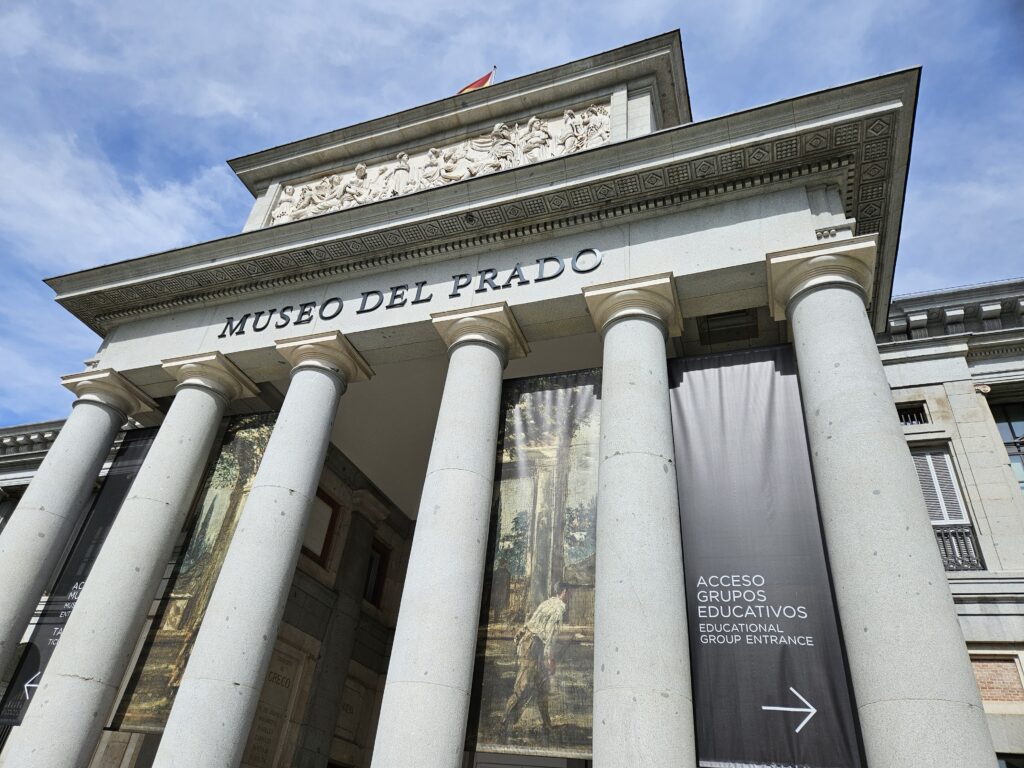
Prado Museum: One of the world’s great museums, with masterpieces by Diego Velázquez, Francisco de Goya, El Greco, Hieronymus Bosch and Albrecht Dürer. The museum has free entry between 6 PM to 8 PM, Sunday 5 to 7 pm, but keep in mind people queue in line 30 to 45 minutes earlier. Also, free entry times the museum is very crowded, lines are extremely long and you have a very short amount of time to spend in the museum prior to closing. Since we reached Madrid on a Sunday, we opted to go for the 5 pm free entry. The line curved the entire length of the whole Prado building, and we waited almost at the very end, since we reached around 4.40 pm or so. But once the line started moving, the line moved quickly, and we got in. If you buy tickets, the lunch time between 2 pm and 4 pm should be quieter. If you visit during free hours, have a plan on which artwork you want to see and do your research on what is where.
Enter from the Jeronimos entrance and pick up a map. After getting past the security check, you will enter the ground floor of the Prado Museum typically, except in our case they moved us to the top floor entrance to speed up the entry process. You will need to check-in bigger bags at the security entrance and keep them there. No photography allowed in the museum. 5 euros to get an audio guide, buy this at museum, else it may not work.
The Prado Museum is huge and has an astounding collection. Since we had only 2 hours, we had to target exactly the artwork that was a priority for us. Las Meninas was my absolute favorite. There are many dark Goya paintings done toward the end of his life, as he slipped into insanity, which I skipped as I prefer happy artwork, but my daughters took a quick glance through them.
Having done my research, our plan was to see the following artwork: –
Level 0
- Room 55A: Landscape with St. Jerome (1516–17)
- Room 56A: The Garden of Earthly delights, Hiëronymus Bosch (1490–1500). This was the most strange, scandalous painting I have ever seen, the left panel represents paradise prior to sin with the fall of Adam and Eve, the central panel shows mankind a slave to every kind of sin and lust, and finally the right panel shows hell, the results of sin, almost like something out of science fiction where sinners are tortured and tormented forever. The message is clear, that fleeting earthly hedonism and sin lead a person to hell.
- Room 49: Raphael, make a U turn, take elevator to level 1
Level 1
- Room 11 and Room 12: Las Meninas – stand in the center of room to admire, Diego Velázquez: Las Meninas 1656. This is an absolutely stunning beautiful painting.
- Also, by Velazquez, The Surrender at Breda, The Triumph of Bacchus, Apollo at the Forge of Vulcan, Christ Crucified, Las Hilanderas
- Rooms 25 to 29: Titian Italian: Room 25 Titian – Equestrian Portrait of Charles V
- Maja Desnuda and La Maja Vestida, The Second and Third of May 1808,
- Room 32: Goya Royal family of Charles IV Francisco Goya: The Family of Charles IV 1800
- Room 23: Giambattista Tiepolo – The Immaculate Conception
Sorolla Museum: We did not have time to visit the Sorolla museum but have read that it is a delightful, intimate collection of portraits and landscapes by Spanish artist Joaquín Sorolla. The house and the gardens are a glimpse into the artist’s life, and the space is like an oasis in the city.
Madrid Restaurants
Madrid has a wide variety of restaurants. Some that we visited included: –
- Mercado de la Reina: Gran Vía, 12, Centro, 28013 Madrid – excellent 3 course meal with their menu del dia, tasty food at a great price.
- La Rollerie: Calle Mayor, 24, Centro – good brunch place, restaurant has lots of seating and very nice ambiance
- La Mallorquina: Puerta del Sol, 8, Centro, 28013: a historic eatery known for its pastries, cakes, coffee/tea, it has a dining area upstairs, take pictures of items you like and show it your server to order. Napolitana pastry, the Rosquillas (soft frosted cookies were delicious), listas are some good items
- La Mi Venta – very small local restaurant, good food but bit pricy
- La Barraca
- Chocolateria San Gines for churros (very delicious and worth visiting, churros in Spain are so much better than ones in America, they are soft and not sugar coated, very tasty)
Shopping in Madrid
Shopping in Madrid was fun and you will find great options to purchase anything you like such as:-
- Zara: flagship store on Gran Via in Madrid’s Plaza de España Calle Gran Vía, 34 28013
- Zara at C. de Serrano, 23, Salamanca, 28001 – this one has better reviews
- Primark – department store on Gran Via 32, Centro, 28013
- El Corte Inglés – Paseo de la Castellana, the largest one with Sfera, own brand
- Taller Puntera – real leather quality goods, at fair prices. Pl. del Conde de Barajas, 4, Centro, 28005
Taxi from city to Madrid airport should be around 30 to 35 Euros. Another way is to get from Príncipe Pío train/metro station to Madrid-Barajas Airport T4 by taking the renfe train which takes 43 min.
The high-speed AVE train station in Madrid is the Puerta de Atocha section in the old part of the station, while the Atocha-Cercanías section has connections to standard-speed trains.